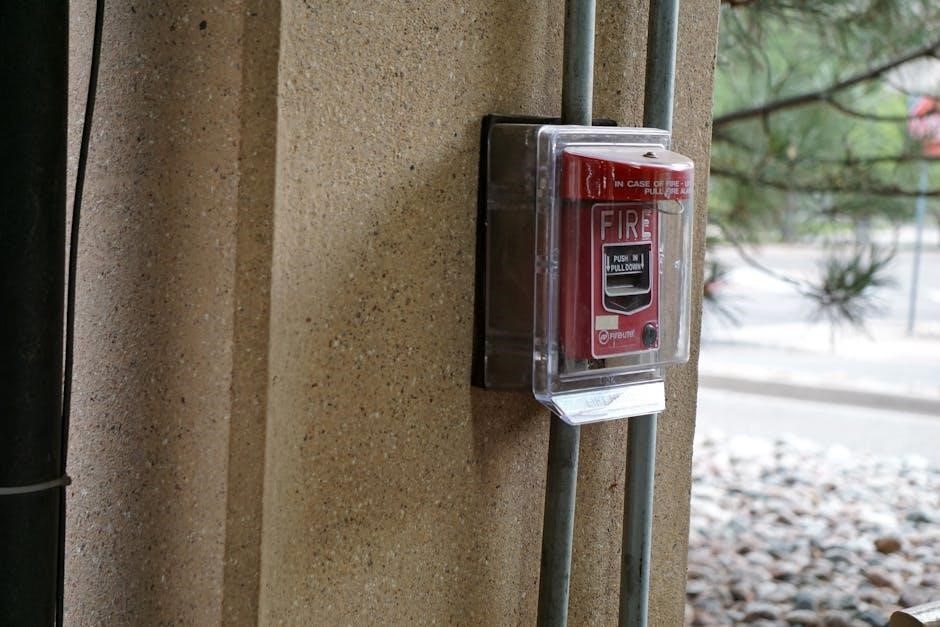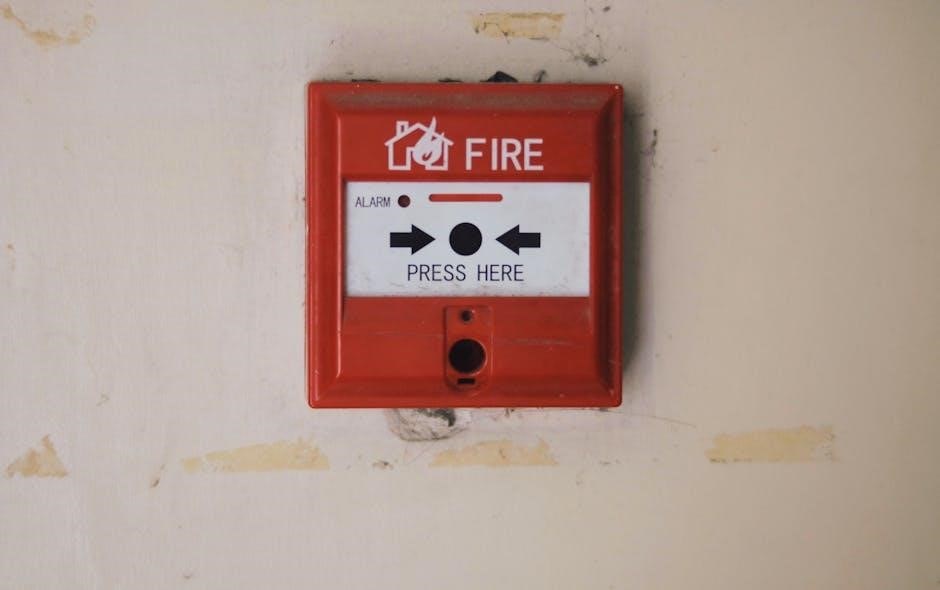A manual fire detection system is a crucial component of fire safety, enabling individuals to alert others in the event of a fire. These systems rely on manual activation, such as pull stations, to trigger alarms and initiate emergency responses. They are simple, reliable, and cost-effective, making them ideal for smaller spaces or supplementary fire safety measures. While they lack automation, manual systems ensure rapid human intervention, which can be critical in early fire detection.

Components of Manual Fire Detection Systems
Manual fire detection systems consist of key components, including manual pull stations, control panels, and wiring. These elements work together to detect and alert individuals of potential fires, ensuring timely evacuation and emergency response. Each component plays a vital role in system functionality and reliability.
2.1. Manual Pull Stations
Manual pull stations are essential components of fire detection systems, designed to be activated by individuals in emergency situations. These stations are typically wall-mounted and feature a lever or button that, when engaged, sends a signal to the control panel, triggering alarms. They are usually bright red for visibility and are placed in accessible locations, such as near exits or in high-traffic areas. Proper installation and maintenance of pull stations ensure reliable performance during emergencies. They are simple yet critical for initiating timely alerts, making them a fundamental part of fire safety infrastructure.
2.2. Control Panels
The control panel is the central hub of a manual fire detection system, serving as the brain that monitors, processes, and coordinates fire alerts. It is typically a sophisticated electronic device designed to receive signals from various components, such as manual pull stations and automated detectors. The control panel analyzes these signals to determine the location and severity of a potential fire, enabling appropriate responses. Modern control panels are programmable, allowing users to customize settings, such as zones, delays, and alarm levels, to suit specific building requirements.
Key features of control panels include visual and auditory indicators, such as LED lights and alarms, to alert personnel of an emergency. They also provide detailed logs of events, aiding in post-incident analysis. Many systems are designed with redundancy and backup power options to ensure reliability during outages. The control panel’s user-friendly interface allows authorized personnel to perform diagnostics, test systems, and silence alarms when necessary. Compliance with fire safety standards is critical, and control panels are built to meet these regulations, ensuring dependable performance in critical situations.
Overall, the control panel plays a pivotal role in managing and coordinating fire response, making it an indispensable component of manual fire detection systems.
2.3. Wiring and Connectivity
Wiring and connectivity are critical elements of manual fire detection systems, ensuring seamless communication between components. The system relies on a network of cables to connect manual pull stations, control panels, and other devices. Proper wiring ensures that signals are transmitted accurately and efficiently, enabling timely responses to emergencies. Typically, fire-resistant cables are used to maintain integrity even during high-temperature events.
The wiring system is designed to follow specific fire safety codes and standards, such as those outlined by the National Fire Protection Association (NFPA). This includes requirements for cable routing, insulation, and connectivity. Proper grounding and insulation are essential to prevent interference and ensure reliable signal transmission. Modern systems often incorporate advanced connectivity options, such as networked systems, to integrate multiple components and enable real-time monitoring.
Installation of wiring must adhere to strict guidelines to avoid faults or failures. Technicians use specialized tools and techniques to test connectivity and ensure the system operates as intended. Regular inspections and testing are also required to maintain the integrity of the wiring and connectivity, ensuring the system remains operational and reliable in the event of a fire emergency.

How Manual Fire Detection Systems Work
Manual fire detection systems operate through human intervention. When a pull station is activated, it sends a signal to the control panel, triggering alarms and notifications. This prompt response helps initiate evacuation and firefighting efforts effectively.
3.1. Activation Methods
Manual fire detection systems rely on human action to initiate an alarm. The primary activation method involves manual pull stations, which are strategically installed in accessible locations throughout a building. These stations typically feature a red handle or lever that, when pulled, sends an electrical signal to the control panel. Upon activation, the control panel processes the signal and triggers audible and visual alarms to alert occupants of a potential fire hazard. In addition to pull stations, some systems incorporate alternative activation methods, such as key-operated switches or digital interfaces, which may be used in specific scenarios or for added security. These methods ensure that individuals can quickly and reliably alert others in the event of a fire, providing critical time for evacuation and emergency response. The simplicity of these activation methods makes them highly effective in initiating a timely response to fire emergencies.

Advantages of Manual Fire Detection Systems
Manual fire detection systems offer several distinct advantages that make them a crucial component of fire safety strategies. One of the primary benefits is their reliability and simplicity. These systems operate on straightforward mechanisms, reducing the likelihood of mechanical failure or false alarms. This reliability ensures that when a fire is detected, the alarm is activated promptly, providing critical time for evacuation and emergency response.
Another significant advantage is cost-effectiveness. Manual systems are generally less expensive to install and maintain compared to automatic fire detection systems. They do not require sophisticated sensors or software updates, making them a practical choice for businesses or organizations with limited budgets. Additionally, their low maintenance requirements contribute to long-term cost savings.
Manual fire detection systems also offer flexibility in placement. Pull stations can be strategically located in high-traffic areas or near exits, ensuring that they are easily accessible in emergency situations. This targeted placement enhances the overall efficiency of the system and contributes to a faster response time.
Furthermore, these systems serve as an effective backup to automated fire detection systems. In the event of a malfunction in an automatic system, manual pull stations provide a reliable means of alerting occupants to a potential fire hazard. This redundancy is essential for ensuring comprehensive fire safety coverage in any building.

Challenges and Limitations of Manual Fire Detection Systems
Manual fire detection systems, while effective in certain scenarios, present several challenges and limitations. One of the primary drawbacks is their reliance on human intervention, which can lead to delays in fire detection and response. Unlike automatic systems that detect fires through sensors, manual systems depend on individuals to identify a fire and activate the alarm, which may not happen promptly, especially in unoccupied areas.
Another limitation is the potential for false alarms. Manual pull stations can be activated accidentally or maliciously, leading to unnecessary evacuations and disruptions. This not only wastes resources but also reduces the credibility of the fire safety system over time, potentially causing complacency among occupants.
Manual systems also lack the ability to detect fires in remote or hard-to-reach areas. In large buildings or complexes, fires in isolated sections may go unnoticed until they spread significantly, reducing the effectiveness of the system. Additionally, manual systems do not provide information about the location or severity of the fire, which can hinder emergency responders’ ability to react efficiently.
Lastly, manual fire detection systems are less suitable for buildings with high fire risks or complex layouts. They may not provide the level of protection required for such environments, making them a less reliable option compared to automated systems.

Installation Requirements for Manual Fire Detection Systems
The installation of manual fire detection systems requires careful planning and adherence to specific guidelines to ensure effectiveness and compliance with safety standards. One of the primary considerations is the placement of manual pull stations. These devices should be installed in easily accessible locations, such as near exits, corridors, and stairways, to facilitate quick activation in emergency situations. According to NFPA 72, pull stations should be mounted at a height of 42 to 48 inches from the floor to ensure accessibility for individuals with disabilities.
The system must also be connected to a central control panel, which monitors the status of all components. Wiring should be installed in accordance with local electrical codes, and fire-resistant cables should be used to prevent damage during a fire. Additionally, the system must be powered by a reliable source, with a backup power supply to ensure functionality during power outages.
Installation should also account for the building’s layout and occupancy type. For example, in large facilities, multiple pull stations should be strategically placed to cover all areas. Finally, all installations must be tested after completion to verify proper operation and compliance with local fire safety regulations.

Maintenance and Testing of Manual Fire Detection Systems
Regular maintenance and testing of manual fire detection systems are essential to ensure their reliability and effectiveness in emergency situations. The system should be inspected and tested according to local fire safety codes and manufacturer recommendations. Weekly visual inspections of pull stations and control panels can help identify issues such as damage or tampering. Monthly testing involves activating pull stations to verify that alarms sound correctly and that the system communicates properly with the control panel.
An annual comprehensive inspection is required, which includes checking wiring, connections, and power supplies. The backup battery should also be tested annually to ensure it can power the system during outages. Cleaning pull stations and control panels is necessary to remove dirt or debris that could interfere with functionality. Additionally, all components should be replaced if they show signs of wear or damage. Proper documentation of maintenance and testing activities is crucial for compliance with safety regulations and to demonstrate system readiness in case of an audit or inspection.
- Weekly: Visual inspection of components.
- Monthly: Functional testing of pull stations.
- Annually: Comprehensive inspection and battery testing.

Compliance and Standards for Manual Fire Detection Systems
Manual fire detection systems must comply with local, national, and international fire safety standards to ensure reliability and effectiveness. Key standards include those set by the National Fire Protection Association (NFPA) and the European Union’s EN 54. NFPA 72, for example, provides detailed requirements for the installation, testing, and maintenance of fire alarm systems, including manual pull stations. Similarly, EN 54 outlines strict guidelines for fire detection systems in Europe, ensuring they meet safety and performance criteria.
Local fire codes often dictate specific requirements for manual fire detection systems, such as the placement of pull stations, the number of control panels, and the integration with other safety systems. Compliance also involves regular inspections and certifications to verify that the system operates as intended. Failure to meet these standards can result in legal penalties, increased liability, and compromised safety.
- NFPA 72: Governs fire alarm systems in the U.S.
- EN 54: European standard for fire detection systems.
- Local fire codes: Additional requirements based on jurisdiction.
Adhering to these standards ensures that manual fire detection systems function reliably in emergencies, protecting lives and property effectively.

Integration with Other Safety Systems
Manual fire detection systems are often integrated with other safety systems to create a comprehensive safety network. This integration enhances the overall effectiveness of fire safety measures by ensuring a coordinated response during emergencies. For instance, manual pull stations can be connected to fire alarm systems, which trigger audible and visual alerts to notify occupants of a potential fire. Additionally, they can be linked to fire suppression systems, such as sprinklers or clean agent systems, to automatically activate when a fire is detected.
Integration with building management systems (BMS) allows for real-time monitoring and control of fire safety components. This connectivity enables security personnel to quickly identify the location of a fire and take appropriate actions. Furthermore, manual fire detection systems can be synchronized with emergency lighting and elevator control systems to facilitate safe evacuation. For example, elevators can be programmed to return to a designated floor, preventing entrapment during a fire.
- Fire alarm and suppression systems
- Emergency lighting and signage
- Elevator control systems
- Building management systems (BMS)
- Access control systems
This seamless integration ensures that manual fire detection systems play a critical role in a unified safety strategy, enhancing the protection of people and property.

Future Trends in Manual Fire Detection Technology
The future of manual fire detection technology is expected to see significant advancements, driven by the integration of smart systems and IoT (Internet of Things) capabilities. One emerging trend is the use of addressable manual pull stations, which provide precise location identification during an emergency, reducing response times and improving efficiency. Additionally, wireless connectivity is becoming more prevalent, allowing manual systems to communicate with central control panels without the need for extensive wiring, thereby reducing installation costs and enhancing scalability.
Another key trend is the incorporation of data analytics and predictive maintenance. Modern manual fire detection systems are being equipped with sensors that monitor usage patterns and detect potential issues before they occur. This proactive approach ensures system reliability and minimizes downtime. Furthermore, there is a growing emphasis on sustainability, with manufacturers developing eco-friendly materials and energy-efficient designs to align with global environmental standards.
These advancements aim to enhance the reliability, efficiency, and integration of manual fire detection systems, ensuring they remain a vital component of fire safety strategies in the years to come.
Key advantages such as affordability, ease of installation, and low maintenance contribute to their widespread adoption. However, it is essential to balance these benefits with the limitations, such as reliance on human action and the potential for false alarms. By integrating manual systems with modern technologies and adhering to compliance standards, organizations can enhance their fire safety protocols while addressing these challenges.
Ultimately, manual fire detection systems serve as a cornerstone of fire safety, ensuring that individuals can take swift action in emergency situations. Their continued evolution and integration with advanced technologies will further solidify their role in safeguarding lives and property.
